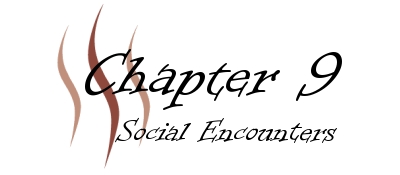Journey Social Combat
The game system encourages a specific type of play. In a system lacking complex social encounter rules, social encounters will likely be less nuanced. In a game that lacks detailed physical combat mechanics, physical combat will be seen as less important, overall.
In Journey's case, the goal is to encourage immersion. Journey is simulationist at its core, and to not encourage any type of play due to lack of mechanics would be an affront to this goal. To achieve this end, social encounter mechanics are needed.
This part of Journey will not be easy to write. There is not a system out there with a completely mechanistic method of dealing with social encounters, given the sheer number of possibilities. While swordslinging is reduced to a single die roll (or type of roll), you cannot do this with social encounters - there is too much risk of completely removing the need for roleplaying in these encounters.
An encounter with the bandit king should be tense, whether you are fighting with words or with swords. But given the fact that Journey combat is dangerous (as it should be), it would make sense to try to bargain first - and this should have the possibility of being more than just a meaningless gesture, as it would in the real world (that is, it would have a chance of working in the real world).
Because this system will probably be confusing and/or complicated, at least at first, I'll be referring to this example often: a party of adventurers is trying to barter with a bandit king, surrounded by bandits. No one is actively hostile, but everyone has half an eye on their weapons. The party wants to convince the bandit king to stop attacking a specific trade route. The bandit king rather enjoys pillaging. Text that relies on this example will be italicized.
Contents
Concept
On your turn, you get a full action. Most social measures require a full action, though some do not; you can use as many social measures in a turn as you have actions.
Social encounter turns are not 6 seconds. While a round may seem fast, each action taken represents anywhere from a witty remark that takes all of three seconds to utter, or a lengthy discourse that could take minutes. Taking an average, each round of a social encounter is 1 minute of world time.
Social encounters do not interact well with melee encounters: when a melee breaks out, that is usually an indication that the time for talking is done, and the time for fighting has begun.
The goal of the system is to make it possible for quiet or shy players to play charismatic, talking-type characters. Therefore, actual roleplaying isn't necessary. However, roleplaying is rewarded, because otherwise it wouldn't be done. Using The Big Lie (a social measure, explained later), if you actually roleplay what the lie is and how it's delivered, this will usually improve your chances of success.
Any social encounter system is going to be very "open design"-esque, because it has to be in order to foster roleplaying. So some aspects of this system are going to be rather subjective.
Descriptors
In 4e, various spells and martial maneuvers have descriptors, much as in 3.5. Social abilities (called "social measures") also have descriptors, which play into how they interact.
The descriptors are...
- Bluff: You bullshit the target.
- Charm: You try to get the target to like you.
- Impress: You try to amaze the target.
- Scare: You try to freak the target out.
- Persuade: You try to convince the target.
Similar to other Journey combat resolution mechanics (physical and spells), social combat has three kinds of offense and defense. These are...
- Wit: A quick wit and sharp tongue can sometimes be used in place of actual arguments. (Charisma-based)
- Logic: Facts, cohesive arguments, and solid reasoning. (Intelligence-based)
- Insight: You form an argument based on emotion, a hunch, or just a general feeling. (Wisdom-based)
For each measure, you roll a wit, logic, or insight roll, which is opposed by one of those three for the target. Your roll is influenced by whatever measure your opponent last used.
An Idea
The RPS theory can apply here, as well.
- Logic beats Wit: Attempting to cajole or belittle an argument presented with solid facts doesn't work so well.
- Wit beats Insight: Emotional arguments with no grounding in facts are easily mocked.
- Insight beats Logic: Touching the heart may work better than touching the mind.
Ego Points (EP) and Disgrace Points (DP)
Ego Points (EP) are similar to hit points. They are an abstract representation of your stake in the social encounter. If you lose all your ego points, your arguments are ignored or pushed aside in favor of someone else's. In a two-sided argument, if all the combatants on one side lose all their EP, the social encounter is over.
Disgrace Points (DPs) are similar to Trauma Points, in that you suffer them whenever an opponent crits you. The more disgrace points you have, the weaker your arguments, and there are often other more far-reaching social implications of having too many disgrace points.
The Mechanics of Social Encounters
Just as there are a multitude of mechanics involved in combat, there are several abilities that relate to social encounters. While related to ability scores, they are disparate, just as attack bonus, defense bonus, and damage output are separate from strength and dexterity.
It should be noted that, in Journey, personality and the role of social combat is treated just as importantly as class and the role of melee combat. While an individual group may decide that one is more important than the other, the system itself assigns the same importance to each; this allows a group to decide which of the two is more important, or to treat them equally.
Character Personality
Just as each character has a class, so, too, does each have a personality. Your personality is the sum of five factors: extraversion, openness, agreeableness, conscientiousness, and neuroticism.
Extraversion
Extraversion is characterized by positive emotions, surgency, and the tendency to seek out stimulation and the company of others. The trait is marked by pronounced engagement with the external world. Extraverts enjoy being with people, and are often perceived as full of energy. They tend to be enthusiastic, action-oriented individuals who are likely to say "Yes!" or "Let's go!" to opportunities for excitement. In groups they like to talk, assert themselves, and draw attention to themselves.
Introverts lack the exuberance, energy, and activity levels of extraverts. They tend to be quiet, low-key, deliberate, and less involved in the social world. Their lack of social involvement should not be interpreted as shyness or depression. Introverts simply need less stimulation than extraverts and more time alone.
There are two extremes to extraversion: extraversion (E) and intraversion (I).
Openness
Openness is a general appreciation for art, emotion, adventure, unusual ideas, imagination, curiosity, and variety of experience. The trait distinguishes imaginative people from down-to-earth, conventional people. People who are open to experience are intellectually curious, appreciative of art, and sensitive to beauty. They tend to be, compared to closed people, more creative and more aware of their feelings. They are more likely to hold unconventional beliefs.
People with low scores on openness tend to have more conventional, traditional interests. They prefer the plain, straightforward, and obvious over the complex, ambiguous, and subtle. They may regard the arts and sciences with suspicion, regarding these endeavors as abstruse or of no practical use. Closed people prefer familiarity over novelty. They are conservative and resistant to change.
There are two extremes to openness: sensing (S) and intuition (N).
Agreeableness
Agreeableness is a tendency to be compassionate and cooperative rather than suspicious and antagonistic towards others. The trait reflects individual differences in concern with for social harmony. Agreeable individuals value getting along with others. They are generally considerate, friendly, generous, helpful, and willing to compromise their interests with others. Agreeable people also have an optimistic view of human nature. They believe people are basically honest, decent, and trustworthy.
Disagreeable individuals place self-interest above getting along with others. They are generally unconcerned with others’ well-being, and are less likely to extend themselves for other people. Sometimes their skepticism about others’ motives causes them to be suspicious, unfriendly, and uncooperative.
There are two extremes to agreeableness: thinking (T) and feeling (F).
Conscientiousness
Conscientiousness is a tendency to show self-discipline, act dutifully, and aim for achievement. The trait shows a preference for planned rather than spontaneous behaviour. It influences the way in which we control, regulate, and direct our impulses. Conscientiousness includes the factor known as Need for Achievement (NAch).
The benefits of high conscientiousness are obvious. Conscientious individuals avoid trouble and achieve high levels of success through purposeful planning and persistence. They are also positively regarded by others as intelligent and reliable. On the negative side, they can be compulsive perfectionists and workaholics.
There are two extremes to conscientiousness: judging (J) and perceiving (P).
Neuroticism
Neuroticism is the tendency to experience negative emotions, such as anger, anxiety, or depression. It is sometimes called emotional instability. Those who score high in neuroticism are emotionally reactive and vulnerable to stress. They are more likely to interpret ordinary situations as threatening, and minor frustrations as hopelessly difficult. Their negative emotional reactions tend to persist for unusually long periods of time, which means they are often in a bad mood. These problems in emotional regulation can diminish a neurotic's ability to think clearly, make decisions, and cope effectively with stress.
At the other end of the scale, individuals who score low in neuroticism are less easily upset and are less emotionally reactive. They tend to be calm, emotionally stable, and free from persistent negative feelings. Freedom from negative feelings does not mean that low scorers experience a lot of positive feelings. Frequency of positive emotions is a component of the Extraversion domain.
There are two extremes to neuroticism: reactive (R) and stable (B).
Crafting a Character's Personality
When you create a character, you have 30 points with which to create your personality.
Each factor is divided into two traits: the extremes listed for each heading. So for agreeableness, you have a score in both thinking (T) and feeling (F). Each trait begins at 5, and the total for each factor must be 10 (so the two factors added together must equal 10). It is possible, during play, for a trait to rise above 10, but doing so is the result of experience (no trait can be below 0).
Variant 1: 10 Point Factors
In this variant, the total of each pair of traits (that is, the total value of a factor) is 10.
TABLE: PERSONALITY TRAIT COSTS VALUE COST 0 15 1 10 2 6 3 3 4 1 5 0 6 1 7 3 8 6 9 10 10 15
Whenever you modify a trait, the trait it is tied to becomes 10 minus the other's value.
Variant 2: 20 Point Factors
In this variant, the total of each pair of traits (that is, the total value of a factor) is 20. Each trait begins at 10.
TABLE: PERSONALITY TRAIT COSTS FACTOR VALUES COST 0 / 20 20 1 / 19 16 2 / 18 13 3 / 17 10 4 / 16 8 5 / 15 6 6 / 14 4 7 / 13 3 8 / 12 2 9 / 11 1 10 / 10 0 11 / 9 1 12 / 8 2 13 / 7 3 14 / 6 4 15 / 5 6 16 / 4 8 17 / 3 10 18 / 2 13 19 / 1 16 20 / 0 20
This presentation is a bit clearer. For each factor, you pick one set of values, pay the cost, and assign them left-to-right.
...the journey of a thousand miles...
|
Journey
|
...begins beneath your feet...
| |||||||||||||||||||||||||
|---|---|---|---|---|---|---|---|---|---|---|---|---|---|---|---|---|---|---|---|---|---|---|---|---|---|---|---|
| |||||||||||||||||||||||||||

